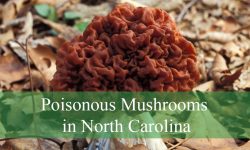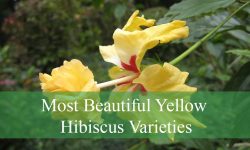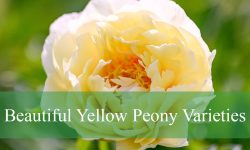When it comes to creating a vibrant and colorful garden, annual flowers that bloom all summer are a gardener’s dream. These plants not only provide non-stop beauty but also offer a wide range of colors, shapes, and sizes to suit any landscape. Whether you’re looking to brighten up a flower bed, add a pop of color to a container, or fill in those empty spots in your garden, these annuals will keep your outdoor space looking fresh and lively from early spring to late fall.
Annual flowers that bloom all summer are perfect for those who want to enjoy continuous color without the worry of perennial blooms fading away. With proper care, these annuals will provide weeks, if not months, of stunning blooms that attract pollinators, enhance curb appeal, and even make for wonderful cut flowers. Plus, with such a variety of options available, you’ll have no trouble finding the perfect match for your garden’s style and needs.
In this guide, we’ll take a closer look at 50 annual flowers that bloom all summer, each offering something unique. From the ever-popular Petunia to the striking Zinnia, we’ll explore these blooms in detail, along with tips on how to care for them. Get ready to transform your garden into a blooming paradise with these vibrant annuals that are sure to stand out all season long.
List of Annual Flowers That Bloom All Summer
Petunia
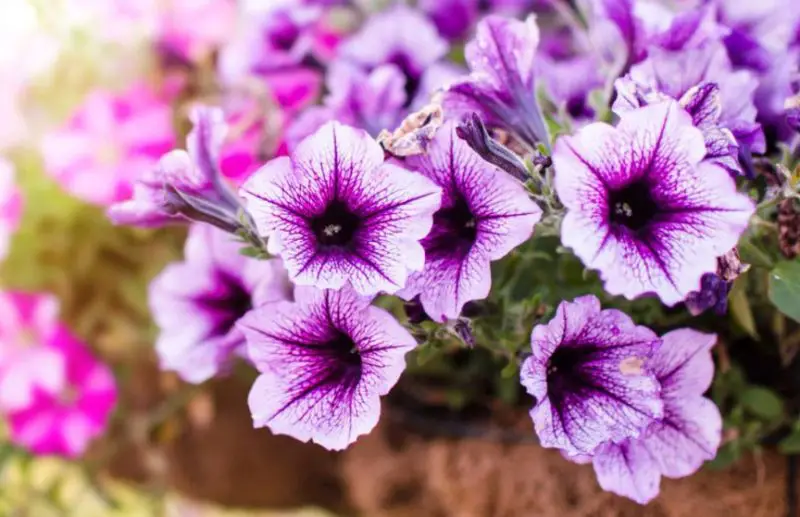
Petunias are classic summer annuals known for their trumpet-shaped flowers and abundant, cascading blooms. These versatile flowers come in a wide range of colors including purple, pink, red, white, yellow, and bicolors. Some varieties also feature ruffled or fringed petals, adding extra texture to garden beds, containers, or hanging baskets.
Petunias thrive in full sun and well-drained soil. Deadheading spent blooms regularly encourages continuous flowering throughout the summer. Water petunias moderately and avoid wetting the foliage to reduce the risk of fungal disease. Fertilizing every couple of weeks with a balanced liquid fertilizer helps maintain lush growth and abundant blooms.
They are typically grown as annuals in USDA hardiness zones 9–11 but can be replanted each year in cooler climates. Petunias start blooming in late spring and continue non-stop until the first frost, making them a top pick for long-lasting color in summer gardens.
Zinnia
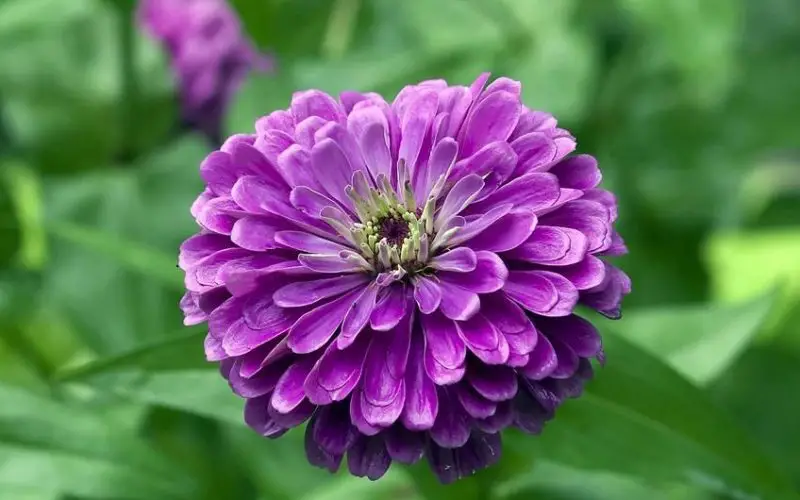
Zinnias are heat-loving annuals that produce bold, daisy-like flowers in a rainbow of colors including red, orange, yellow, pink, purple, and white. Their upright stems and dense flower heads make them ideal for cutting gardens and pollinator-friendly landscapes. Varieties range in size from compact bedding types to tall cultivars for borders.
Zinnias grow best in full sun and require well-drained soil. They are low-maintenance and highly drought-tolerant once established. For the longest bloom period, deadhead regularly and avoid overhead watering. Space them properly to promote airflow and prevent powdery mildew, especially in humid climates.
Zinnias are suitable for USDA zones 2–11 as annuals and bloom from early summer until the first frost. With their fast growth and vibrant color, zinnias are perfect for filling in empty spaces and attracting butterflies to the garden.
Marigold (Tagetes)
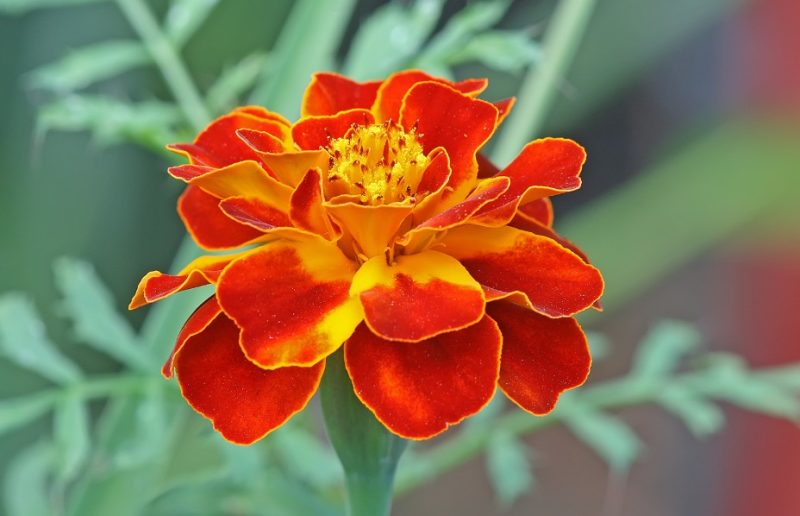
Marigolds are cheerful, sun-loving annuals recognized for their bright yellow, gold, and orange blooms. The most common types include French marigolds (Tagetes patula), African marigolds (Tagetes erecta), and signet marigolds (Tagetes tenuifolia), each offering different flower sizes and growth habits. Their distinctive scent can also help deter garden pests.
They flourish in full sun and well-draining soil and are tolerant of poor soil conditions. Marigolds are easy to grow from seed and are relatively pest-free. Water regularly but do not overwater, as soggy soil can lead to root rot. Deadheading helps prolong the blooming season.
These hardy annuals are grown in USDA zones 2–11 and bloom prolifically from late spring until fall. Their low maintenance and pest-repelling qualities make them great companion plants for vegetables and herbs.
Verbena

Verbena is a sun-loving annual that forms clusters of small, five-petaled flowers in shades of purple, pink, red, blue, and white. With a sprawling habit and long-lasting blooms, it’s an excellent choice for hanging baskets, borders, and containers. Some cultivars offer a trailing habit, while others stay compact and upright.
Verbena thrives in full sun and well-drained soil and is highly tolerant of heat and drought. Regular watering and monthly feeding with a balanced fertilizer will keep plants healthy and blooming. Trim back the stems mid-season to encourage a new flush of growth and flowers.
Verbena can be grown as an annual in USDA zones 3–8 and as a tender perennial in zones 9–11. It blooms from late spring through fall, attracting butterflies and adding color to garden spaces all summer long.
Lantana
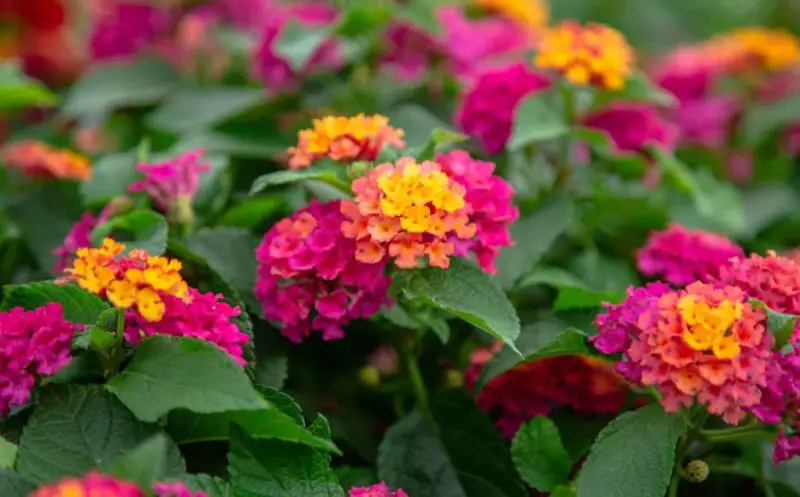
Lantana is a vibrant annual (or perennial in warm climates) that produces small, clustered flowers in brilliant shades of red, orange, yellow, pink, and purple, often appearing in multicolored combinations. The flowers are highly attractive to butterflies and pollinators, and the plant develops a shrubby or trailing form depending on the variety.
Lantana prefers full sun and well-drained soil and is drought-tolerant once established. It requires minimal maintenance—just occasional pruning to shape and encourage new blooms. Be cautious, as the leaves and berries can be toxic if ingested by pets or children.
This heat-loving plant is perennial in USDA zones 9–11 but is grown as an annual in cooler zones. Lantana blooms continuously from late spring through the first frost, offering long-lasting color with minimal fuss.
Calibrachoa (Million Bells)
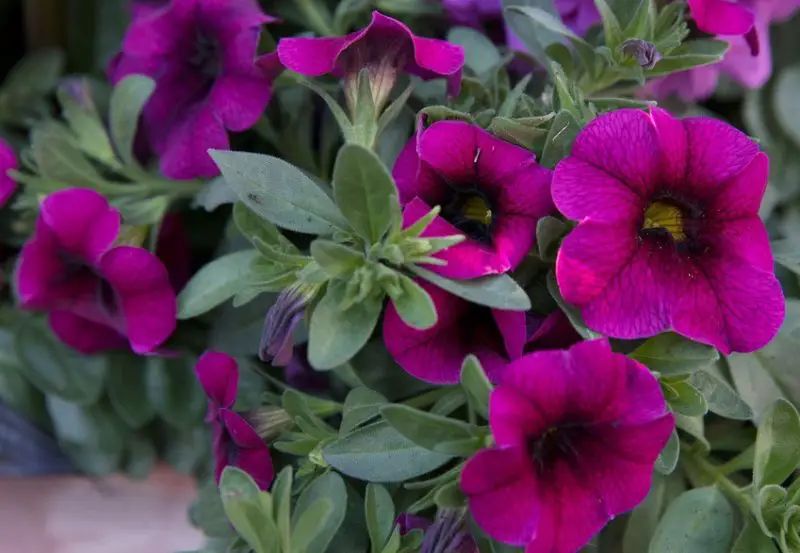
Calibrachoa, commonly called Million Bells, is a trailing annual known for its profusion of tiny, petunia-like blooms in nearly every color imaginable—pink, yellow, red, blue, violet, and multicolored blends. Its mounding or cascading habit makes it ideal for containers, hanging baskets, and window boxes.
These flowers thrive in full sun and well-draining soil, although they appreciate some afternoon shade in very hot climates. Calibrachoa needs regular watering but should not sit in soggy soil. Feed with a liquid fertilizer every couple of weeks to encourage continual blooming. Unlike petunias, they don’t usually require deadheading.
They are annuals in most regions but can behave as short-lived perennials in USDA zones 9–11. Calibrachoa blooms from late spring to frost, producing masses of vibrant flowers that create a carpet of color throughout the season.
Geranium (Pelargonium)
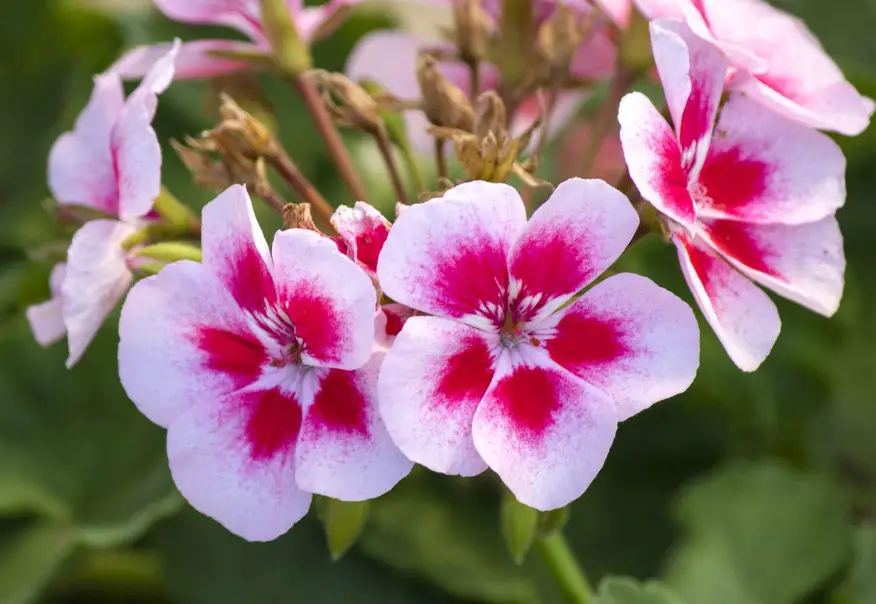
Geraniums, particularly Pelargonium species, are popular annuals celebrated for their rounded flower clusters and deeply lobed, sometimes scented foliage. Their blooms come in red, pink, salmon, white, and violet, adding vibrant splashes of color to window boxes, pots, and borders. Upright varieties are common, but trailing types are also available for hanging baskets.
They prefer full sun to partial shade and thrive in well-drained soil. Overwatering is a common issue, so allow the soil to dry between waterings. Deadhead regularly to encourage continuous blooming. Applying a balanced fertilizer every few weeks promotes healthy foliage and vibrant flowers throughout the growing season.
Pelargonium geraniums are grown as annuals in most areas but may overwinter indoors in USDA zones 10–11. These flowers typically bloom from late spring through fall and are favored for their resilience in hot, dry summer conditions.
Impatiens (New Guinea & Bedding)
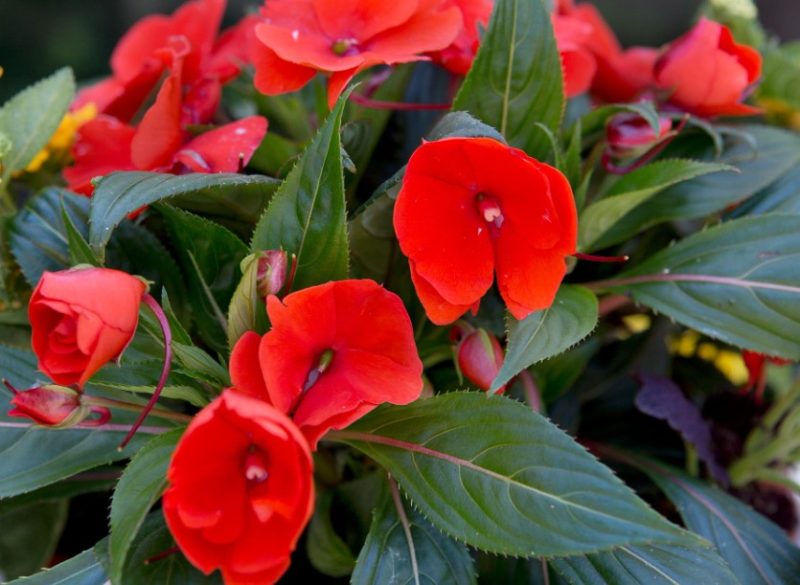
Impatiens are shade-loving annuals prized for their continuous blooms and lush, green foliage. Bedding impatiens (Impatiens walleriana) are smaller and ideal for ground cover, while New Guinea types (Impatiens hawkeri) have larger blooms and more pronounced foliage. Available colors include red, pink, white, lavender, orange, and bi-color combinations.
They grow best in partial to full shade and moist, well-drained soil. Keep the soil consistently damp but not soggy. Fertilize regularly to maintain blooming, especially in containers. Avoid windy spots and excessive heat, which can cause stress and leaf drop in these tender plants.
Impatiens are annuals in USDA zones 2–9 and tender perennials in zones 10–11. They bloom from spring to the first frost, providing reliable color in shady spots where few other annuals thrive.
Begonia (Wax and Fibrous types)
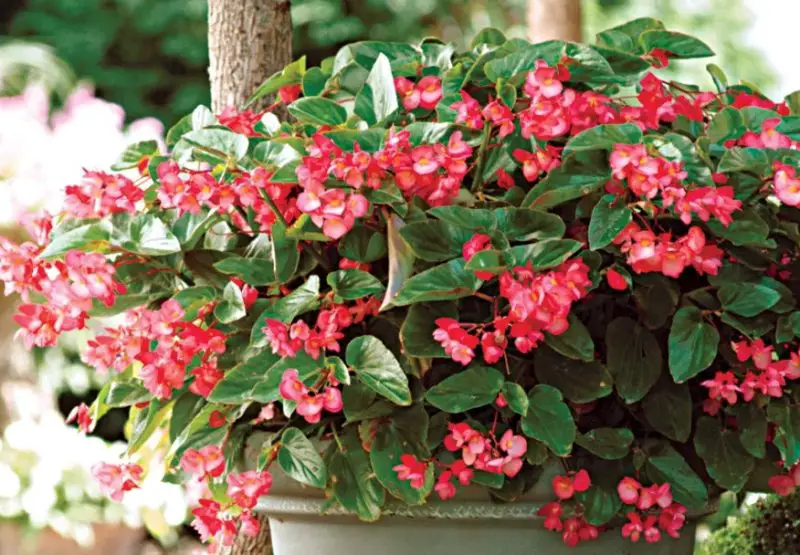
Wax and fibrous begonias are compact, bushy annuals known for their fleshy leaves and single or double flowers in pink, white, red, and coral. Their glossy green or bronze foliage adds contrast to flower beds and borders. These begonias are versatile and tolerate sun or shade depending on the variety.
They prefer well-drained soil and moderate watering. Avoid overhead watering to prevent leaf spots and mildew. Plant in areas with good airflow and feed monthly with a balanced fertilizer to support healthy growth and frequent blooms.
Begonias are grown as annuals in USDA zones 3–9 and as perennials in zones 10–11. They bloom continuously from late spring through summer, making them ideal for edging, containers, and mass plantings.
Salvia (Annual types)

Annual salvias are striking flowering plants that produce tall spikes of tubular blooms in red, purple, blue, pink, and white. Known for their upright growth habit and ability to attract hummingbirds, they make excellent additions to mixed borders and pollinator gardens.
They thrive in full sun and well-drained soil, requiring little maintenance once established. Regular deadheading encourages more blooms, and occasional feeding with a bloom-boosting fertilizer helps sustain flowering. Salvias are also drought-tolerant, making them suitable for xeriscaping.
These annual types are grown in USDA zones 3–10 and bloom from early summer until the first frost. Their vertical form adds height and movement to garden beds and containers throughout the warm season.
Vinca (Periwinkle)

Vinca, also known as Madagascar periwinkle (Catharanthus roseus), is a heat-tolerant annual with glossy green foliage and flat, star-shaped flowers in pink, white, lavender, and red. It’s a favorite for sunny beds and borders, especially in hot and humid regions where few other annuals thrive.
Vinca thrives in full sun and well-draining soil, and it’s highly resistant to drought and fungal issues. Avoid overwatering, and let the soil dry between waterings. There’s no need to deadhead, as the plant self-cleans and continues blooming without intervention.
Grown as an annual in USDA zones 2–9 and as a tender perennial in zones 10–11, vinca blooms profusely from late spring to frost. Its ability to withstand heat, humidity, and low water makes it one of the most reliable summer bloomers.
Nicotiana (Flowering Tobacco)
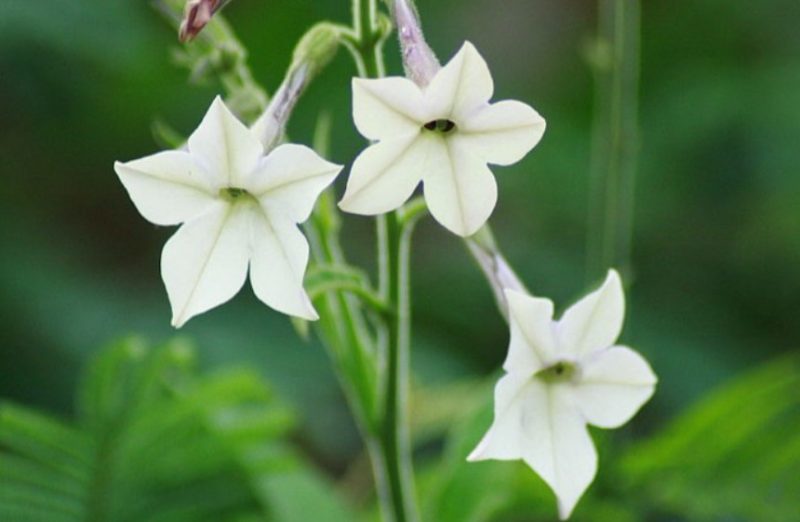
Nicotiana, or flowering tobacco, is a fragrant annual with tubular, star-shaped flowers that open in the evening or early morning. It’s available in shades of white, pink, red, green, and lavender, and some varieties emit a sweet scent that attracts nighttime pollinators like moths.
Nicotiana prefers full sun to partial shade and moist, fertile soil. Regular watering and light feeding encourage prolonged blooming. Taller varieties may need staking, while compact types are excellent for containers and edging. Deadheading spent blooms will extend the flowering season.
It is grown as an annual in USDA zones 3–10 and may return in warmer areas as a short-lived perennial. Nicotiana blooms from early summer through fall and adds a romantic, cottage-garden feel to any space.
Cosmos
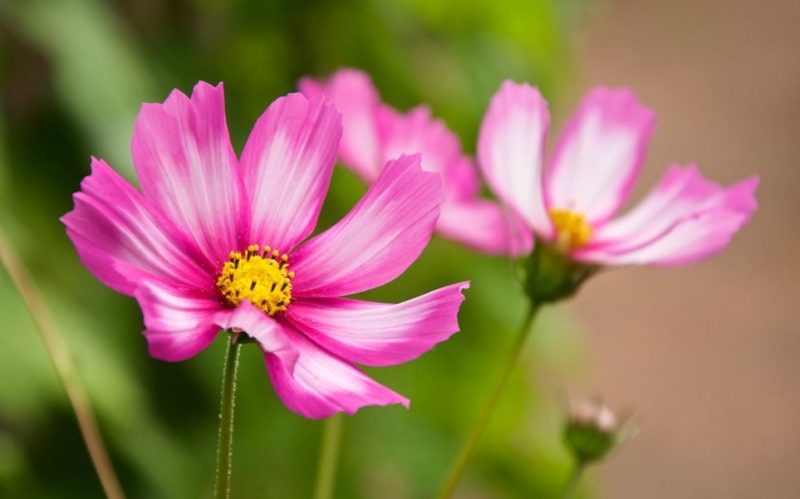
Cosmos are delicate, airy annuals that produce daisy-like flowers atop tall, slender stems. They come in cheerful colors like white, pink, magenta, and orange, and their fern-like foliage gives a soft, whimsical texture to gardens. These flowers sway gently in the breeze and are especially popular in cottage and wildflower-style gardens.
Cosmos thrive in full sun and average, well-draining soil. They prefer poorer soils and require minimal fertilization, as overly rich soil can reduce blooming. Deadheading spent blooms will encourage continuous flowering throughout the summer, and taller varieties may benefit from staking in windy areas.
These easy-to-grow annuals are suitable for USDA zones 2–11 and bloom from early summer until frost. Cosmos are excellent for cutting gardens, pollinator plots, and areas where a naturalized look is desired.
Cleome (Spider Flower)
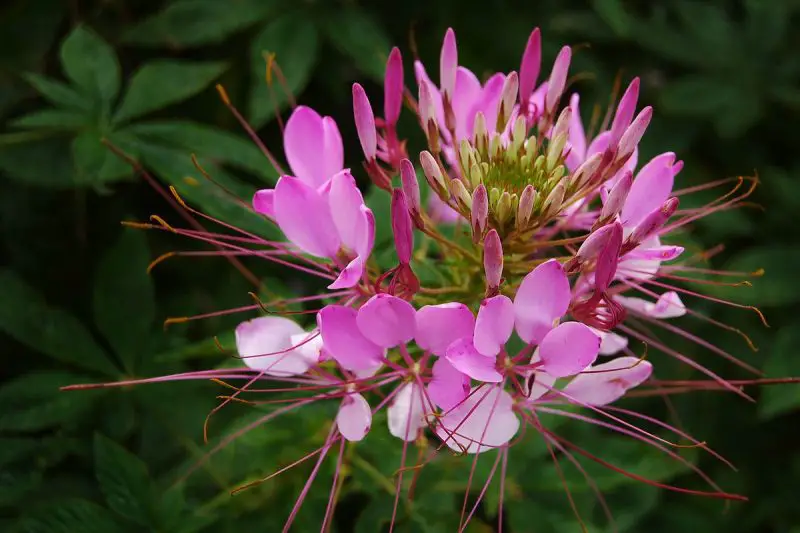
Cleome, also known as spider flower, is a bold, architectural annual with spidery blooms in shades of pink, lavender, white, and purple. The tall, spiky flower heads give a dramatic look, and the narrow seedpods that follow add continued interest. Its unique structure draws attention and pairs well with other tall summer bloomers.
Cleome prefers full sun and moderately fertile, well-draining soil. Once established, it is drought-tolerant and low maintenance. While some varieties self-seed, others are sterile hybrids. Planting in blocks rather than rows helps the plants support one another and reduces the need for staking.
This flower thrives in USDA zones 2–11 as an annual and blooms from early summer through fall. It attracts bees, butterflies, and hummingbirds, making it a valuable addition to wildlife-friendly gardens.
Portulaca (Moss Rose)
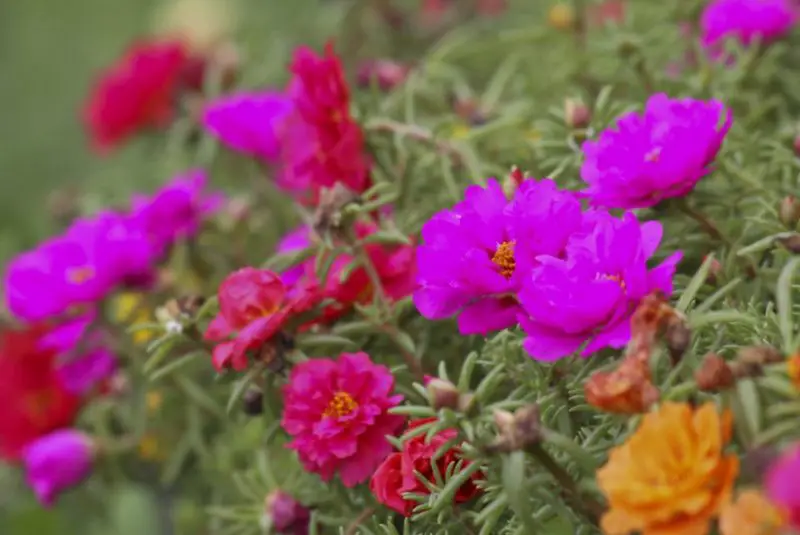
Portulaca, or moss rose, is a low-growing annual with succulent leaves and vibrant, rose-like blooms in red, orange, yellow, pink, white, and bi-color shades. The flowers open in the sun and close at night or on cloudy days, giving a dynamic effect to sunny spaces. Its spreading habit makes it ideal for edging, rock gardens, and containers.
This drought-tolerant plant thrives in hot, sunny spots with sandy, well-drained soil. Portulaca requires very little care once established. Avoid overwatering, and do not plant in heavy or soggy soil, as root rot can occur. It needs no deadheading and often reseeds itself if conditions are right.
Portulaca is best suited for USDA zones 2–11 as an annual and blooms continuously from late spring through summer. Its resilience in heat and dry soil makes it one of the most dependable summer groundcovers.
Torenia (Wishbone Flower)

Torenia, commonly known as wishbone flower, is a shade-loving annual with trumpet-shaped blooms in blue, violet, pink, and white. The name comes from the small wishbone-shaped stamens found inside the flower. With a compact, bushy habit, torenia is a great choice for hanging baskets, containers, and shady beds.
It prefers partial to full shade and moist, well-draining soil rich in organic matter. Regular watering and a balanced fertilizer will keep plants healthy and blooming throughout the season. Torenia does not require deadheading, making it an easy-care option for low-light areas.
Grown as an annual in USDA zones 2–9 and as a tender perennial in zones 10–11, torenia blooms from early summer to fall. Its continuous flowering and ability to brighten shady corners make it a favorite in woodland gardens and porch planters.
Celosia (Cockscomb & Plume types)
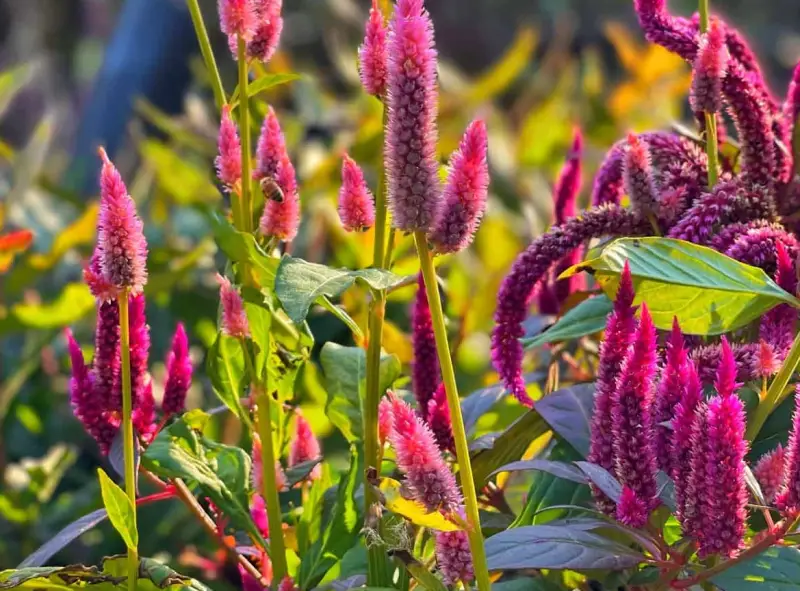
Celosia is a vibrant annual with unusual flower forms, including feathery plumes and brain-like cockscomb shapes. These blooms come in intense shades of red, orange, pink, yellow, and purple, adding bold texture and color to summer gardens. The plant’s upright growth and striking flowers make it a standout in beds and borders.
Celosia thrives in full sun and well-draining, fertile soil. Water regularly, especially during dry spells, but avoid overwatering to prevent root issues. Removing spent flowers encourages more blooms. Plume types grow taller and bushier, while cockscomb types stay more compact.
This heat-loving plant performs well in USDA zones 2–11 as an annual and flowers from late spring to frost. Celosia is ideal for cutting gardens and dried flower arrangements due to its long-lasting blooms and unique texture.
Gaillardia (Blanket Flower – grown as an annual in some zones)
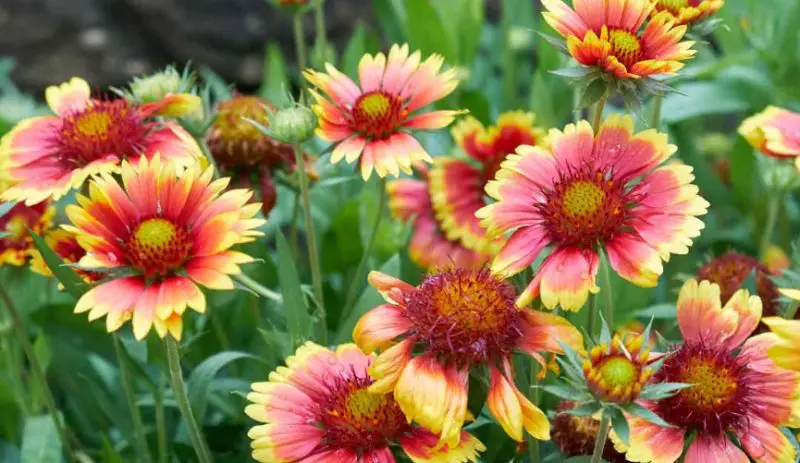
Gaillardia, or blanket flower, is a cheerful bloomer with daisy-like flowers in red, orange, and yellow tones. The petals often have a bicolor look with contrasting tips and centers, creating a fiery, sunset-like appearance. Though technically a short-lived perennial, it’s often grown as an annual in cooler climates.
Gaillardia prefers full sun and well-drained soil and tolerates heat, drought, and poor soil with ease. Avoid rich soil and excess watering, which can lead to legginess. Deadheading helps prolong the bloom period, and the plant can reseed itself in favorable conditions.
Blanket flower grows well in USDA zones 3–10 and blooms from early summer until frost. Its tolerance to tough growing conditions and its appeal to pollinators make it a valuable and low-maintenance addition to sunny gardens.
Snapdragon (in cooler summer areas)
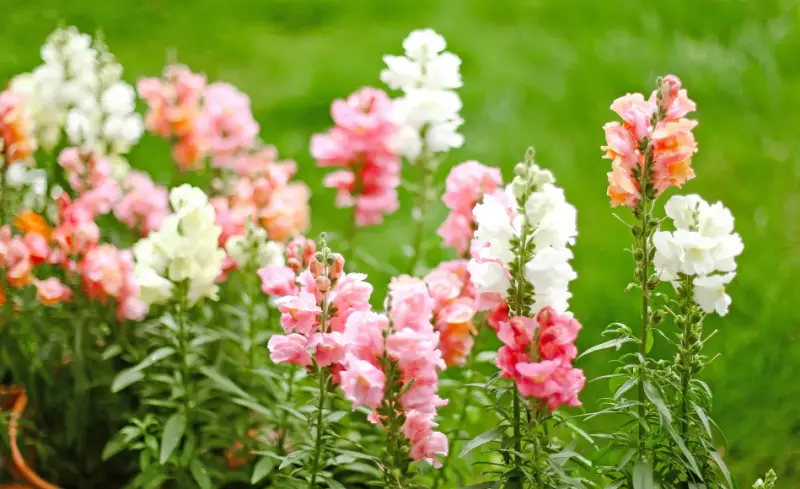
Snapdragons are beloved for their tall spikes of tubular flowers that bloom in a wide range of colors including red, pink, yellow, white, and purple. These charming blooms resemble a dragon’s mouth when pinched, which gives them their name. Though often associated with spring, snapdragons can continue blooming into summer in cooler climates.
They prefer full sun to partial shade and moist, well-draining soil. In hot areas, afternoon shade can help prolong their flowering season. Regular deadheading encourages more blooms, and taller varieties may need staking. Pinching young plants can promote bushier growth.
Snapdragons are best grown as annuals in USDA zones 2–9 and as short-lived perennials in zones 10–11. They bloom from late spring to midsummer and even into early fall in areas with mild summers.
Ageratum (Floss Flower)
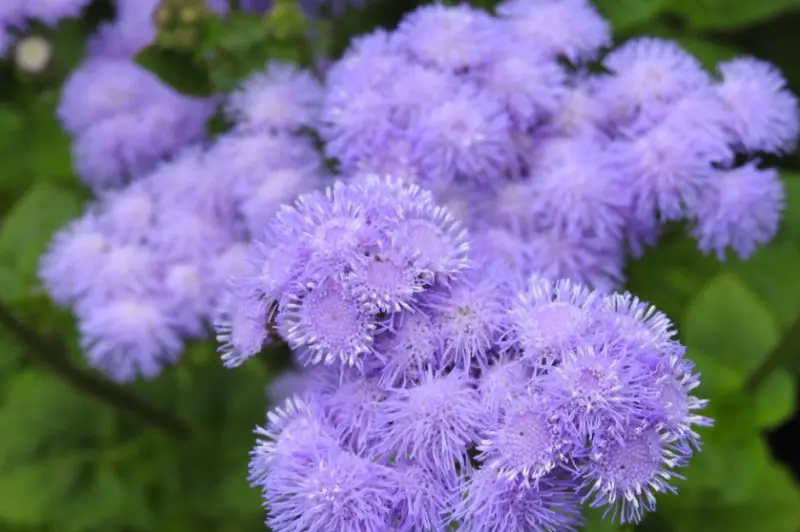
Ageratum, commonly known as floss flower, produces soft, fuzzy clusters of blooms in shades of blue, lavender, white, and pink. Its compact form and unique texture make it a favorite for borders, containers, and mass plantings. Blue varieties are especially prized for providing a rare hue in the flower garden.
Ageratum thrives in full sun to partial shade and prefers moist, fertile soil that drains well. Regular watering and occasional deadheading will keep plants looking fresh and full of blooms. Taller varieties may need spacing or light support to prevent flopping.
Grown as an annual in USDA zones 2–11, ageratum begins blooming in late spring and continues through the summer months. Its long-lasting flowers are excellent for attracting butterflies and adding cool tones to warm-season displays.
Sweet Alyssum
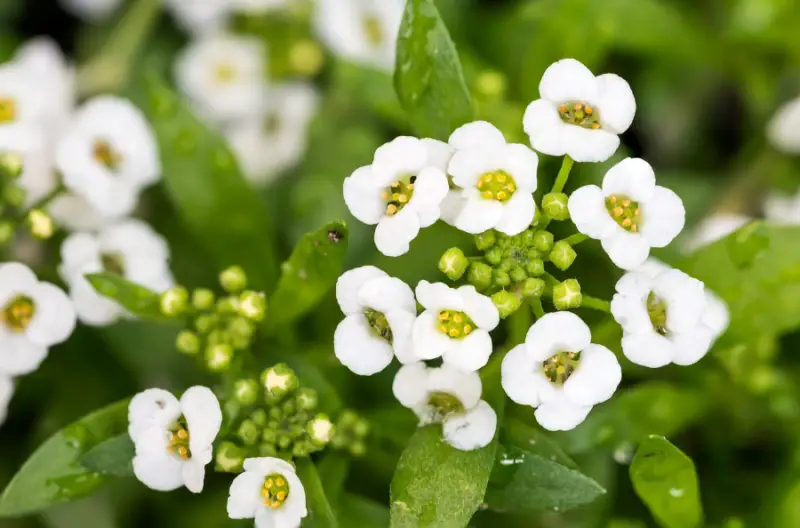
Sweet alyssum is a delicate, fragrant annual known for its low-growing mounds of tiny flowers in white, pink, lavender, or purple. Its honey-like scent and dainty blooms make it ideal for edging, rock gardens, and hanging baskets. It forms a soft, cloud-like mat that spills gently over containers and walls.
This flower prefers full sun to partial shade and well-drained soil. It tolerates light drought once established but blooms best with regular watering. Deadheading or shearing plants back mid-season can encourage a fresh flush of flowers.
Suitable for USDA zones 2–11 as an annual, sweet alyssum blooms from spring until frost, especially thriving in cooler summer regions. Its fragrance and ability to self-sow make it a lovely addition to cottage-style gardens.
Dusty Miller

Dusty miller is valued for its silvery-gray foliage rather than its small yellow flowers, which are often removed to keep the plant’s appearance tidy. The intricately lobed leaves provide beautiful contrast when paired with colorful blooms, making it a common companion plant in flower beds and containers.
It prefers full sun and well-draining soil, tolerating drought and heat with ease once established. Watering should be moderate, and pruning helps maintain a compact, rounded shape. Though typically grown for its foliage, dusty miller can bloom in late summer if allowed.
Grown as an annual in USDA zones 3–8 and as a tender perennial in zones 9–11, dusty miller adds interest from early summer through frost. Its resilience and silvery color make it especially useful in sun-soaked landscapes and formal garden designs.
Sunflower (Dwarf & Branching types for repeat blooms)
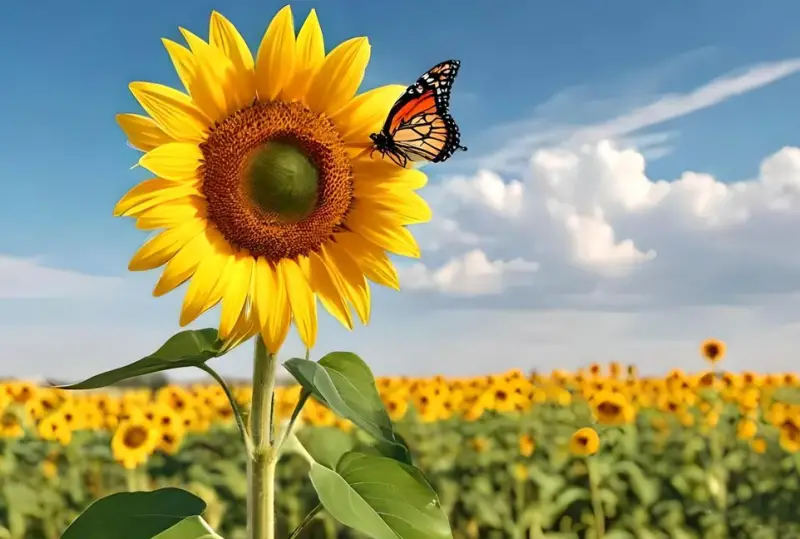
Sunflowers are iconic summer flowers known for their large, cheerful faces and bright yellow petals. Dwarf and branching varieties offer continuous blooms throughout the season, unlike the single-flowering giant types. These sunflowers range in height from just 1 to 5 feet and come in hues of yellow, orange, red, and burgundy.
They thrive in full sun and need well-drained, fertile soil. Water deeply but infrequently to promote deep root growth. Branching varieties benefit from occasional deadheading to extend the bloom season, and dwarf types are ideal for pots or small garden spaces.
Sunflowers are grown as annuals in USDA zones 2–11 and bloom from mid-summer into fall. Besides being ornamental, they attract pollinators and birds, adding beauty and ecological value to summer gardens.
Four O’Clocks (Mirabilis jalapa)
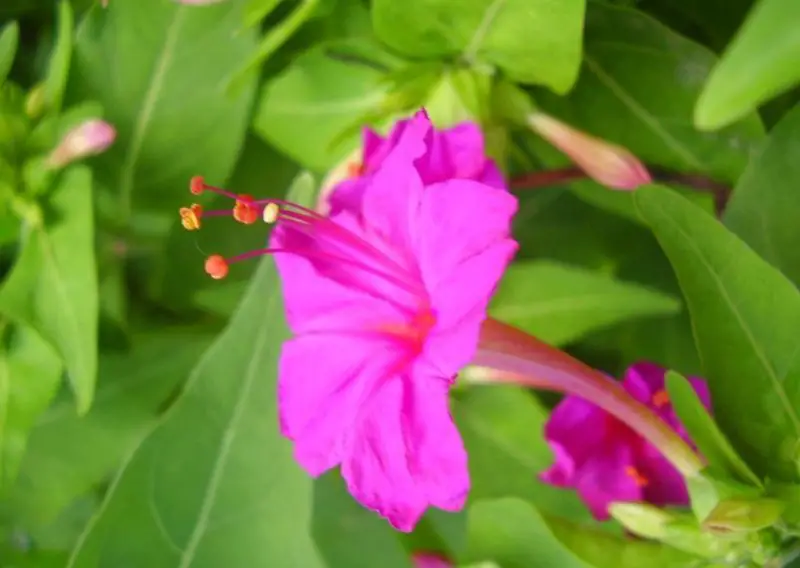
Four o’clocks are fragrant, trumpet-shaped flowers that open in the late afternoon, hence their common name. They come in an array of colors including pink, red, yellow, white, and even bicolors. Each plant can produce multiple colors on different blooms, adding a playful, unexpected touch to the garden.
These flowers grow best in full sun and well-drained soil, although they can tolerate poor conditions. They require moderate watering and generally do not need fertilization. Once established, four o’clocks are low maintenance and often reseed themselves for the next season.
Typically grown as annuals in USDA zones 2–7 and as perennials in zones 8–11, they bloom from mid-summer through fall. Their evening fragrance and vibrant blooms make them excellent for planting near patios and walkways.
Morning Glory (Ipomoea – blooms daily)
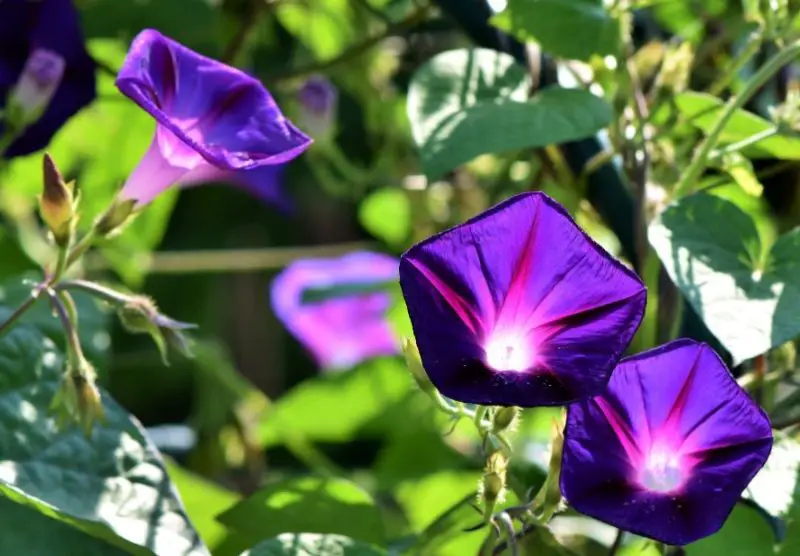
Morning glory is a fast-growing vine known for its trumpet-shaped flowers that unfurl each morning and close by afternoon. These vibrant blooms come in shades of blue, purple, pink, and white, often with striking star-like patterns. The heart-shaped leaves and twining stems make morning glories ideal for fences, trellises, and arbors.
They thrive in full sun and prefer well-drained soil. Morning glories grow quickly from seed and require little maintenance once established. For best results, soak seeds overnight before planting and provide a sturdy structure for climbing. Regular watering is important, especially during dry spells.
Grown as annuals in USDA zones 2–11, morning glories begin blooming in midsummer and continue until the first frost. They’re perfect for adding vertical color and charm to summer gardens and are often used to create natural screens or living walls.
Nasturtium
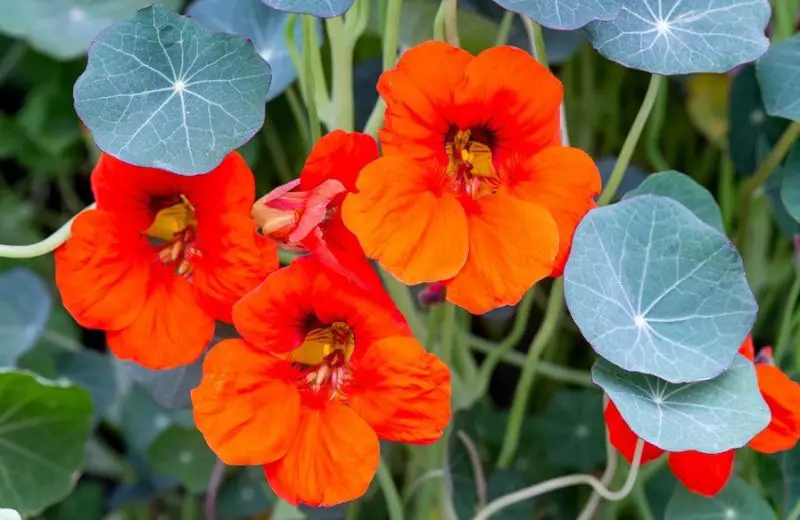
Nasturtiums are cheerful and easy-to-grow annuals with bright, funnel-shaped flowers in shades of orange, red, and yellow. Both the flowers and rounded, lily pad-like leaves are edible, with a peppery flavor that makes them popular in salads. They trail or bush depending on the variety, offering versatility for garden beds and containers.
These plants prefer full sun and poor to moderately fertile soil. Too much fertilizer can lead to lush foliage at the expense of flowers. Nasturtiums are drought-tolerant once established and benefit from regular deadheading to extend blooming. They can also be used as companion plants to deter pests in vegetable gardens.
Suitable for USDA zones 2–11 as annuals, nasturtiums bloom from late spring through summer into fall. Their low maintenance and edible qualities make them favorites among beginner gardeners and culinary enthusiasts alike.
Browallia (Bush Violet)
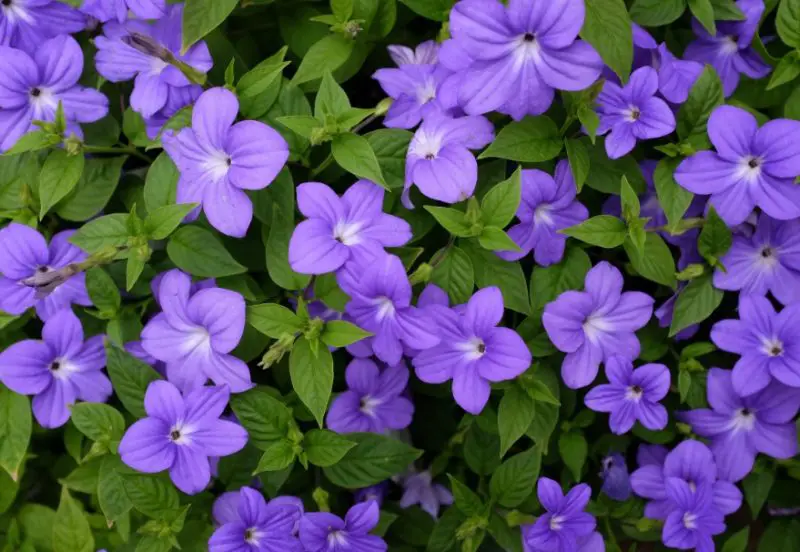
Browallia, or bush violet, is a compact, shade-loving annual with starry flowers in shades of violet-blue, lavender, and white. Its soft, velvety foliage and delicate blossoms provide cool tones to shady borders, hanging baskets, and container arrangements. It’s especially valued for blooming reliably in low-light conditions.
This plant thrives in partial to full shade and prefers moist, well-drained soil. It requires consistent watering and benefits from occasional feeding with a balanced fertilizer. Since it doesn’t need deadheading, browallia is very low-maintenance and continues blooming without much care.
Grown as an annual in USDA zones 2–11, browallia flowers from early summer through fall. It’s perfect for brightening shaded patios, north-facing beds, or underplanting beneath larger foliage plants like hostas and ferns.
Scaevola (Fan Flower)
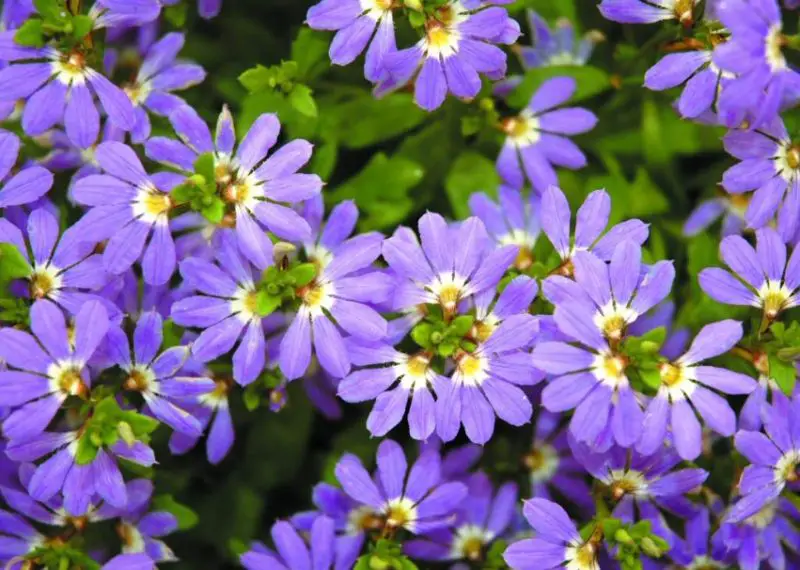
Scaevola, also known as fan flower, features unique fan-shaped blooms that radiate out like a half-daisy. These flowers come in shades of purple, blue, white, and pink, blooming abundantly on trailing stems. Scaevola is heat-tolerant and drought-resistant, making it an excellent choice for summer containers and hanging baskets.
It prefers full sun and well-draining soil, and it thrives in hot, dry conditions where other plants might struggle. Minimal care is needed—just water during dry spells and avoid overwatering. Scaevola is self-cleaning, so no deadheading is required, which adds to its ease of care.
Best grown as an annual in USDA zones 2–11, scaevola blooms nonstop from late spring until frost. Its trailing habit and tough constitution make it a favorite for sunny balconies, borders, and coastal gardens.
Cuphea (Cigar Plant or Bat-faced Cuphea)
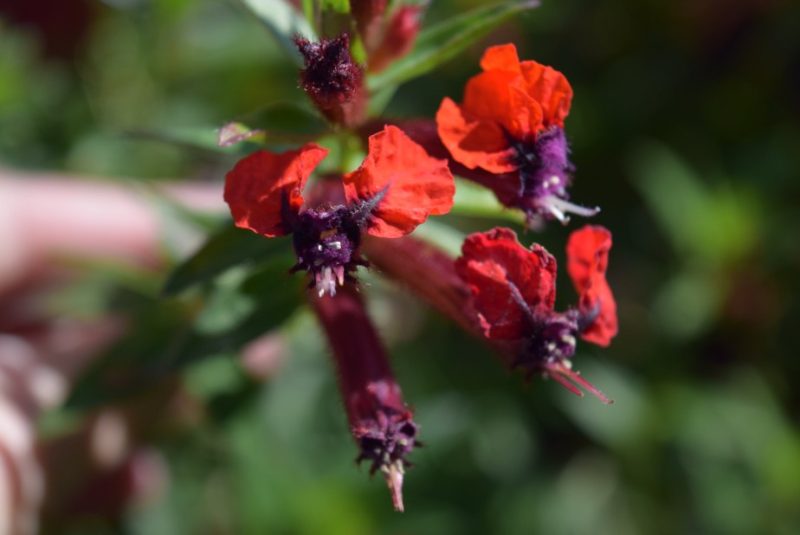
Cuphea is a tropical-looking annual with small, tubular flowers that resemble cigars or little bats, depending on the species. These vibrant blooms come in shades of red, orange, purple, and pink and attract hummingbirds and butterflies throughout the growing season. Its dense, shrubby habit makes it suitable for borders and mixed containers.
It thrives in full sun and well-drained soil and appreciates consistent moisture, especially in hot weather. Cuphea benefits from regular feeding with a balanced fertilizer and continues blooming all summer with minimal deadheading. Mulching can help retain soil moisture and reduce weed competition.
Grown as an annual in USDA zones 2–9 and as a tender perennial in zones 10–11, cuphea flowers from early summer until frost. Its unique appearance and wildlife appeal make it a standout in sunny flower beds and pollinator gardens.
Gomphrena (Globe Amaranth)

Gomphrena, or globe amaranth, produces clover-like, papery flower heads in vibrant shades of magenta, purple, red, white, and orange. The blooms are long-lasting both on the plant and when dried, making them ideal for fresh and dried floral arrangements. Its upright, branching habit gives it a bushy appearance in the garden.
It prefers full sun and thrives in hot, dry conditions with well-drained soil. Gomphrena is very drought-tolerant and low-maintenance, needing only occasional watering and little to no fertilization. Deadheading can encourage more blooms, though it’s not strictly necessary for continuous flowering.
This tough annual grows well in USDA zones 2–11 and blooms from midsummer through fall. Its heat resilience, rich color, and long vase life make it a favorite for summer borders, butterfly gardens, and cutting beds.
Amaranthus

Amaranthus is a dramatic annual plant known for its bold foliage and striking flower plumes or tassels. Depending on the variety, it can have upright spires or trailing, rope-like flowers in shades of red, burgundy, green, and gold. Some cultivars also feature colorful leaves in deep purples and vibrant greens, adding texture to garden beds.
Amaranthus thrives in full sun and well-draining soil. It prefers warm temperatures and benefits from consistent watering during dry periods. This plant is relatively easy to grow and doesn’t require much fertilization—overfeeding may encourage leaf growth over flowers. Taller varieties might need staking to prevent flopping in windy areas.
Grown as an annual in USDA zones 2–11, amaranthus begins blooming in midsummer and continues until frost. It’s ideal for cutting gardens, ornamental beds, and creating visual contrast in mixed plantings thanks to its unusual shape and rich coloration.
African Daisy (Osteospermum – some hybrids bloom all summer)
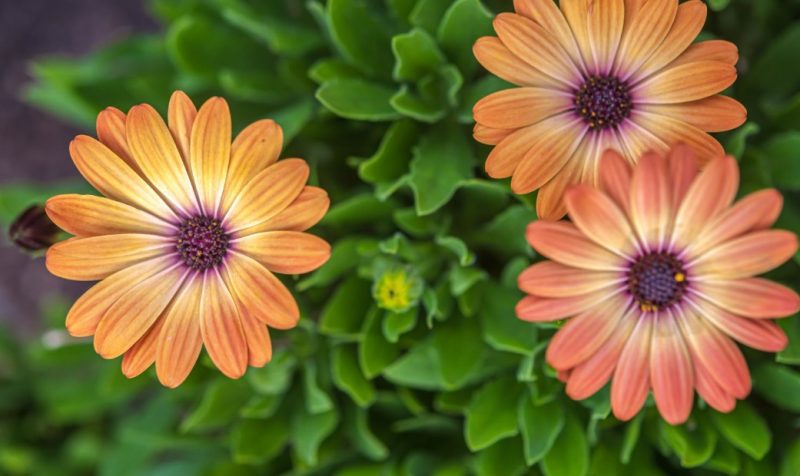
African daisy, or Osteospermum, is a stunning annual with daisy-like blooms in vivid colors such as white, purple, orange, and yellow, often with contrasting centers or iridescent hues. Modern hybrids are bred to bloom continuously through summer, even in hot conditions, making them perfect for long-season interest.
These plants prefer full sun and well-drained soil. They can tolerate drought once established but will bloom best with regular watering. Deadheading helps maintain flower production, though many new varieties are self-cleaning. Avoid overly rich soil, which may result in more foliage and fewer blooms.
Suitable for USDA zones 9–11 as tender perennials and grown as annuals elsewhere, African daisies bloom from late spring into fall. They are a great choice for sunny beds, borders, and containers, offering a burst of color with minimal fuss.
Gazania (Treasure Flower)
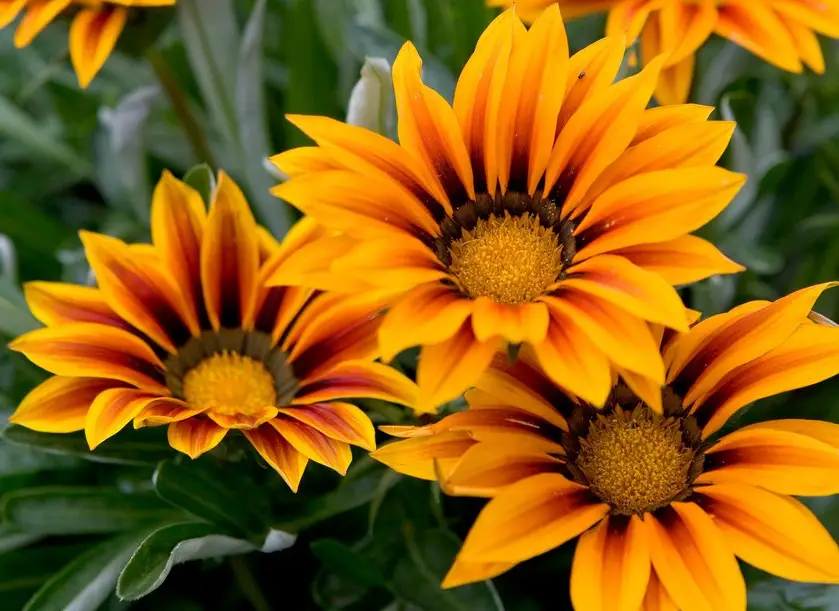
Gazania, also known as treasure flower, is a low-growing, sun-loving annual that produces large, daisy-like flowers in bold shades of orange, yellow, red, pink, and white. Many varieties have contrasting stripes or rings of color, creating a vibrant, eye-catching display. The blooms open during daylight and close at night or on cloudy days.
This heat- and drought-tolerant plant thrives in full sun and poor, sandy, or well-drained soils. It requires little maintenance beyond occasional watering and prefers dry conditions to damp soil. Overwatering can lead to root rot, so it’s important to let the soil dry between waterings.
Grown as an annual in USDA zones 2–9 and as a short-lived perennial in zones 10–11, gazania flowers from early summer until frost. It’s an excellent choice for rock gardens, edging, and containers where bold color and toughness are needed.
Tithonia (Mexican Sunflower)
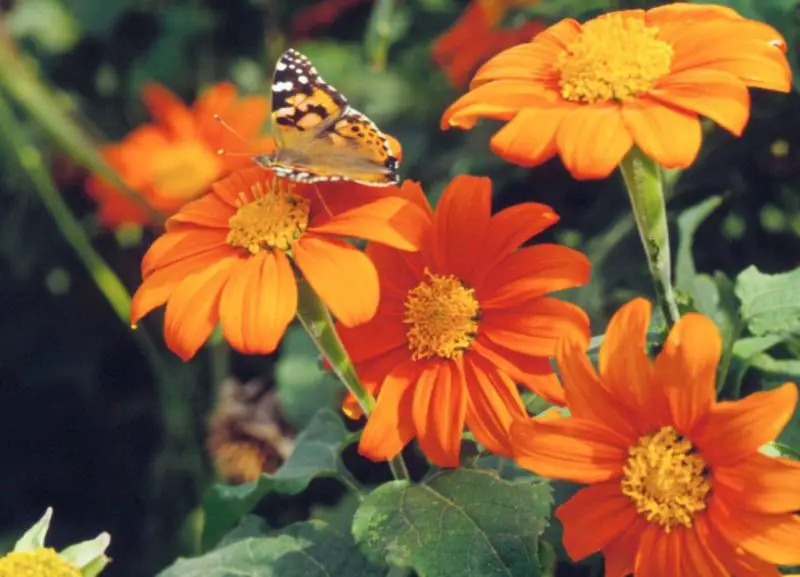
Tithonia, or Mexican sunflower, is a tall, bushy annual that produces brilliant orange or red, daisy-like flowers loved by butterflies and hummingbirds. Its bold blooms and rough-textured foliage give it a wild, cottage garden charm, and the plant can reach heights of 4 to 6 feet.
It thrives in full sun and well-drained soil and is very heat- and drought-tolerant once established. Tithonia grows quickly and needs plenty of space to spread. While staking may be necessary for taller plants, it generally requires little maintenance and blooms prolifically with minimal care.
Ideal for USDA zones 2–11 as an annual, tithonia starts blooming in midsummer and continues until frost. It’s a favorite for pollinator gardens, back borders, and areas needing vertical color or natural screening.
Phlox (Annual varieties)

Annual phlox is a compact, flowering plant that produces masses of small, star-shaped flowers in pink, white, red, violet, and bicolor forms. It offers a soft, cottage-style appearance and is often used to fill in the front of flower beds or containers with colorful clusters.
This plant prefers full sun but can tolerate partial shade, especially in hotter climates. It does best in well-drained, fertile soil and benefits from regular watering to keep the blooms coming. Deadheading spent flowers encourages longer flowering and a tidy appearance.
Grown as an annual in USDA zones 2–11, annual phlox begins blooming in late spring and continues into early fall. It’s ideal for filling gaps in the garden and providing continuous color in sunny to lightly shaded spots.
Pentas
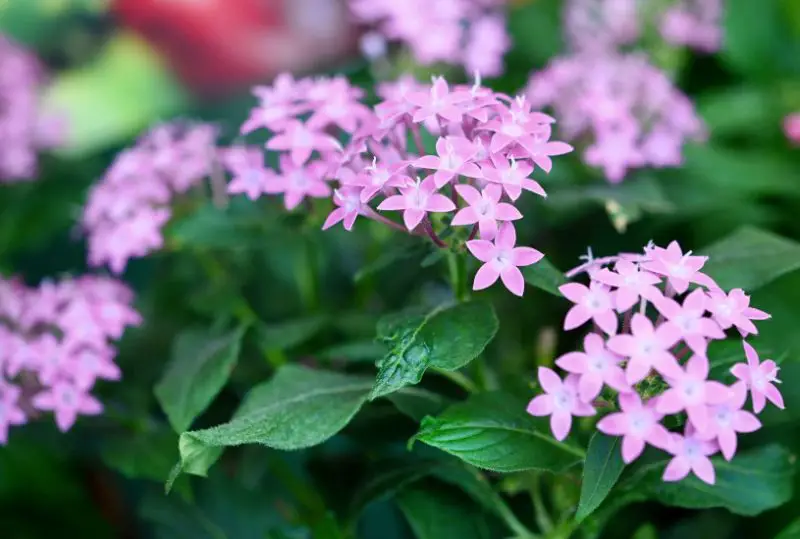
Pentas is a heat-loving annual that produces clusters of star-shaped flowers in shades of red, pink, lavender, and white. The blooms are rich in nectar, attracting butterflies, bees, and hummingbirds all summer long. It has a bushy, upright growth habit and is popular in pollinator gardens and containers.
Pentas grows best in full sun and well-drained soil. It appreciates consistent moisture and occasional feeding with a balanced fertilizer. Deadheading helps maintain a tidy shape and encourages fresh blooms, although some varieties are self-cleaning.
Grown as a perennial in USDA zones 10–11 and as an annual elsewhere, pentas flowers from late spring through the first frost. Its long blooming season and pollinator appeal make it a must-have for wildlife-friendly and summer-themed gardens.
Bacopa
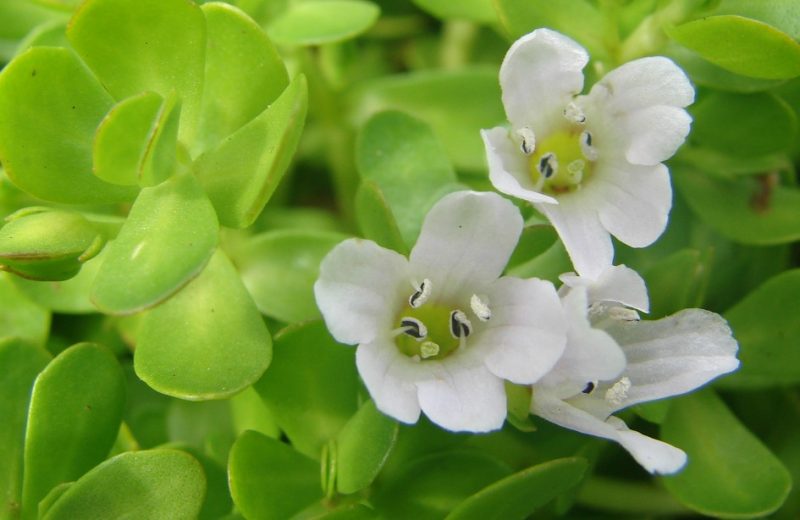
Bacopa is a trailing annual that features a delicate, cascading habit and small, five-petaled blooms in shades of white, lavender, pink, and blue. It’s often used in hanging baskets, containers, and as ground cover due to its lush green foliage and airy flowers that bloom continuously through the summer months.
This plant prefers full sun to partial shade and thrives in moist, well-drained soil. Regular watering is essential, especially in containers, as bacopa can wilt quickly in dry conditions. It benefits from a balanced fertilizer every few weeks and occasional trimming to keep it tidy and encourage new blooms.
Suitable for USDA zones 9–11 as a tender perennial and grown as an annual elsewhere, bacopa begins blooming in late spring and continues until frost. Its trailing form and soft colors make it a charming addition to mixed arrangements or low borders.
Heliotrope

Heliotrope is a fragrant annual known for its rich, violet to deep purple flower clusters and sweet, vanilla-like scent. The dense blooms attract pollinators like butterflies and bees, while the dark green foliage adds to its ornamental appeal. Some cultivars may also have white or lavender-toned flowers.
It thrives in full sun to light shade and requires fertile, well-drained soil. Regular watering and feeding with a bloom-boosting fertilizer will support its flowering throughout the season. Pinching back spent blooms encourages bushier growth and more continuous flowering.
Grown as an annual in USDA zones 2–9 and as a tender perennial in zones 10–11, heliotrope blooms from early summer until frost. It’s perfect for containers, flower beds near seating areas, and any garden space where fragrance and color are desired.
Lobelia (heat-tolerant varieties like ‘Techno Heat’)
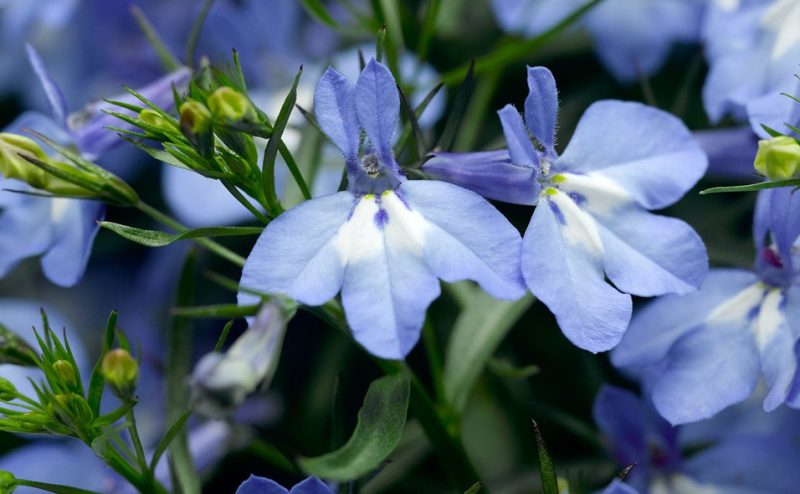
Heat-tolerant varieties of lobelia, such as the ‘Techno Heat’ series, offer the beauty of classic lobelia with improved summer performance. These compact plants produce masses of tiny, fan-shaped flowers in shades of blue, purple, white, and pink. Their mounding or trailing habit makes them ideal for containers and borders.
Lobelia prefers full sun in cooler climates but benefits from partial shade where summers are hot. It grows best in consistently moist, well-drained soil and may require more frequent watering during peak heat. Deadheading is usually unnecessary for heat-tolerant types, as they tend to be self-cleaning.
In USDA zones 2–11, heat-tolerant lobelia blooms from spring through early fall. These improved cultivars are perfect for extending the bloom time of this traditionally cool-weather favorite well into the summer.
Nemesia (reblooming types)
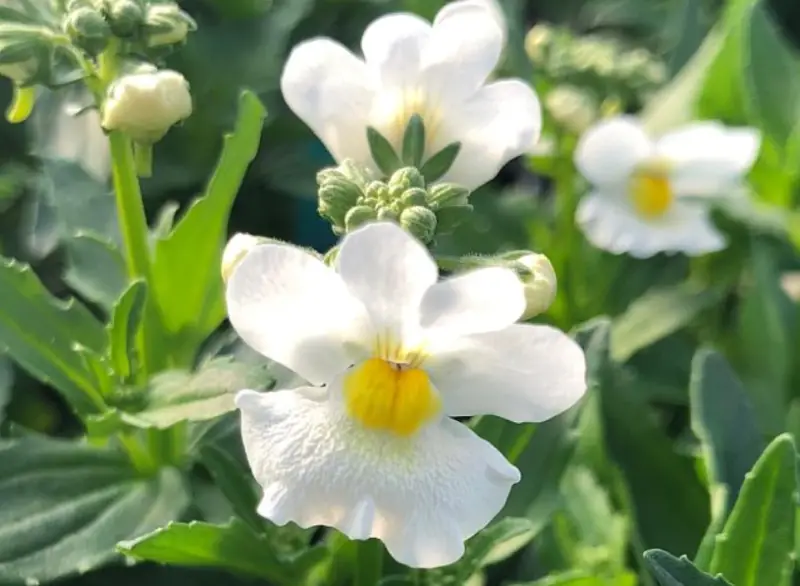
Nemesia is a dainty, upright annual that offers a profusion of small, snapdragon-like flowers in a wide range of colors including pink, orange, white, purple, and bicolor varieties. Reblooming types are especially valued for their long-lasting display and ability to thrive through summer.
It prefers full sun to part shade and grows best in cool, moist, well-drained soil. Regular watering and deadheading will help prolong the flowering period, and applying a balanced liquid fertilizer every few weeks encourages vigorous blooming. In very hot climates, it may appreciate some afternoon shade.
Nemesia is typically grown as an annual in USDA zones 2–10, with reblooming varieties flowering from spring through early fall. It’s a wonderful choice for patio pots, borders, and garden edges where you want cheerful color and compact form.
Bidens

Bidens is a vigorous, low-growing annual that produces a dazzling display of daisy-like flowers in shades of yellow, gold, orange, and white. It has a trailing or mounding habit that makes it ideal for baskets, mixed containers, and ground cover applications.
This sun-loving plant thrives in well-drained soil and requires minimal care once established. It’s highly drought-tolerant and continues to bloom even in heat and dry conditions. Occasional trimming and deadheading can help maintain shape and promote new blooms, although many modern hybrids are self-cleaning.
Hardy in USDA zones 8–11 but grown as an annual in cooler regions, bidens blooms from late spring through fall. It is an excellent performer in hot climates and offers long-season color with very little maintenance.
Canna Lily (grown as annual in cooler zones)
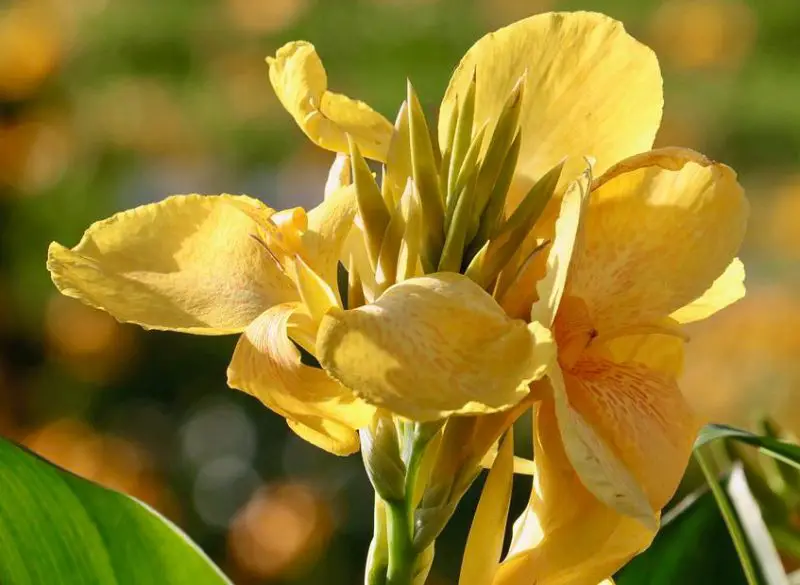
Canna lilies are bold, tropical-looking plants with large, banana-like leaves and striking flower spikes in shades of red, orange, yellow, and pink. Although technically tender perennials, they are often grown as annuals in cooler zones for their dramatic foliage and vibrant blooms.
They thrive in full sun and rich, moist, well-drained soil. Regular watering and monthly feeding with a high-phosphorus fertilizer encourage continuous flowering and lush growth. Canna rhizomes can be dug up and stored over winter in cold climates, then replanted in spring.
In USDA zones 7–11, cannas may survive the winter outdoors, while in zones 2–6, they are best treated as annuals or lifted for overwintering. Their bold structure and long bloom time from mid-summer to frost make them a favorite for tropical-themed gardens and large containers.
Lisianthus
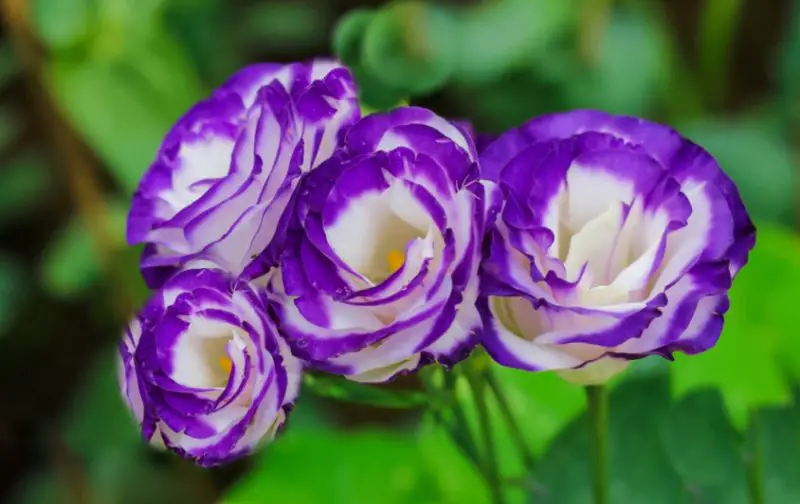
Lisianthus is an elegant annual prized for its rose-like blooms that come in shades of white, pink, lavender, purple, and even bi-colors. The flowers have a soft, ruffled appearance and can grow on long stems, making them popular in cut flower arrangements. Their refined look and wide color range bring a sophisticated touch to garden beds and containers.
Lisianthus prefers full sun and well-drained, rich soil. It requires consistent moisture but dislikes soggy conditions, so good drainage is key. While slow to start from seed, it performs well from transplants. Fertilize monthly during the growing season to promote healthy blooms, and deadhead regularly to extend flowering.
Grown as an annual in USDA zones 2–10, lisianthus blooms from early summer through fall. It’s a bit more demanding than other annuals but rewards gardeners with stunning flowers and a long-lasting display.
Balsam (Impatiens balsamina)
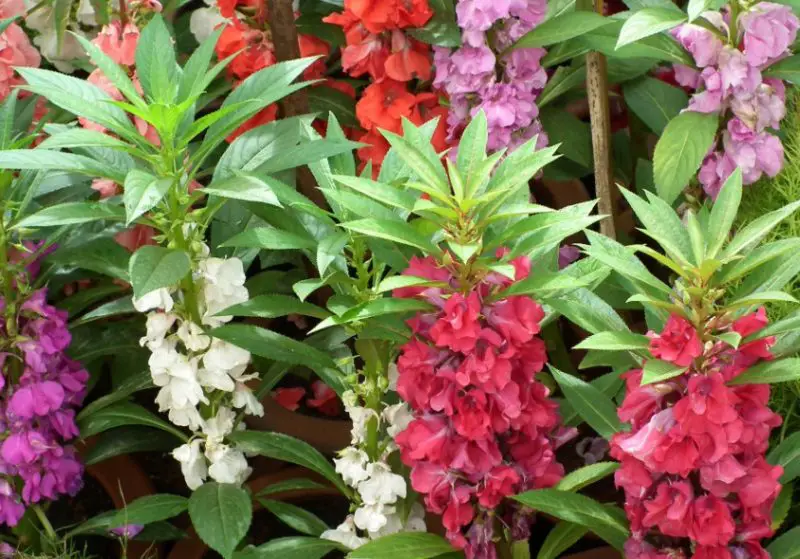
Balsam, also known as garden balsam or rose balsam, is a charming annual with thick, succulent stems and soft, rose-shaped flowers nestled among the foliage. The blooms come in shades of pink, red, purple, white, and orange. This plant has a slightly vintage appeal and is often grown in cottage gardens.
It thrives in full sun to part shade and grows best in moist, well-drained soil. Balsam benefits from regular watering and will perform best when spaced adequately to prevent mildew. It’s an easy-to-grow plant that reseeds readily in favorable conditions. Removing spent blooms can help encourage more flowers.
Balsam is suitable for USDA zones 2–11 and flowers from early summer until frost. It’s especially useful for filling in shady or semi-shaded spots with continuous color and old-fashioned charm.
Rudbeckia hirta (Annual Black-Eyed Susan)
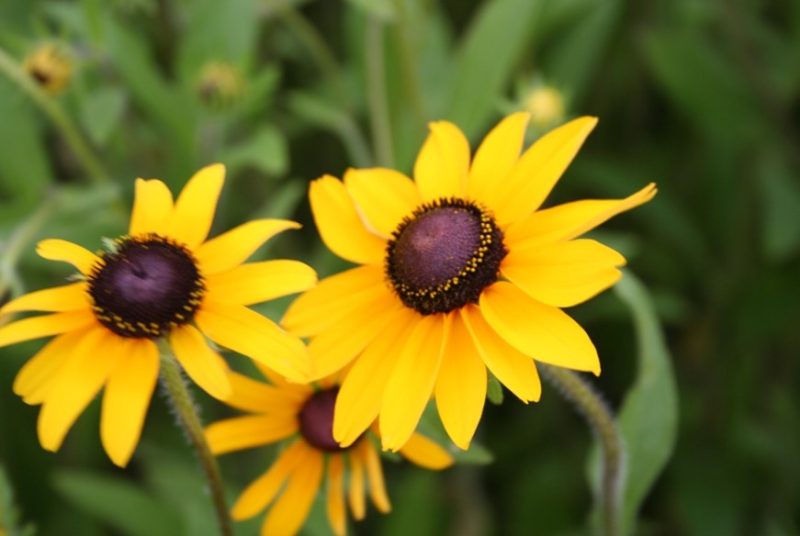
Rudbeckia hirta, commonly known as Black-Eyed Susan, is an iconic wildflower often grown as an annual in cooler climates. It features bold, daisy-like flowers with golden-yellow petals and a dark brown or black central cone. The blooms are eye-catching and attract pollinators, especially bees and butterflies.
This plant thrives in full sun and tolerates a wide range of soil types, though it prefers well-drained, moderately fertile ground. It’s drought-tolerant once established and requires minimal maintenance beyond occasional deadheading to prolong blooming. Rudbeckia is also deer-resistant and great for naturalized plantings.
In USDA zones 3–7, it is typically grown as a biennial or short-lived perennial, while in colder or warmer regions, it performs beautifully as an annual. Blooming from mid-summer to fall, Rudbeckia adds bright color and classic appeal to borders and prairie-style gardens.
Love-in-a-Mist (Nigella)
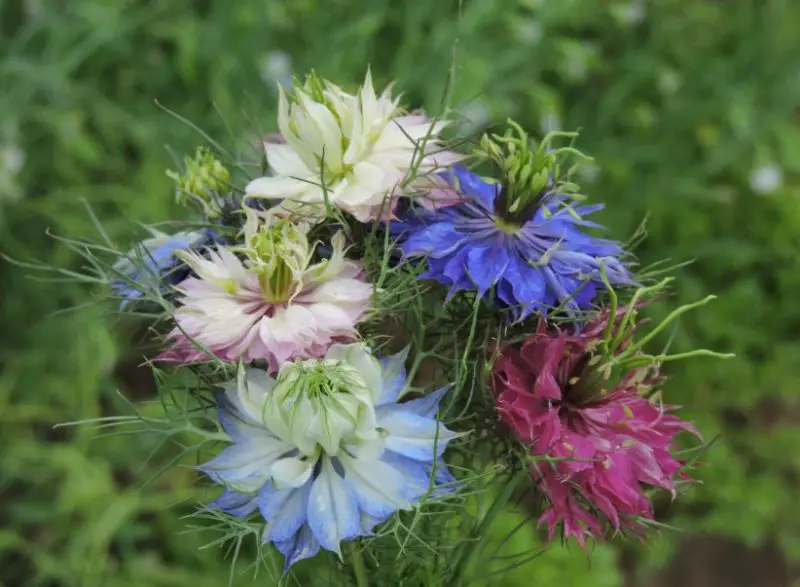
Love-in-a-Mist, or Nigella, is a whimsical annual known for its delicate, feathery foliage and unusual flowers in shades of blue, white, pink, and purple. The blooms are followed by striking, balloon-like seed pods that are often used in dried flower arrangements. Its romantic, lacy appearance suits cottage gardens perfectly.
Nigella prefers full sun and thrives in well-drained soil. It is best direct-sown in early spring, as it doesn’t transplant well. Once established, it is relatively drought-tolerant and low maintenance. It will readily self-seed in favorable conditions, creating a naturalized look in future seasons.
Hardy in USDA zones 2–11 as a cool-season annual, Nigella blooms in late spring through early summer. With its ethereal charm and dual value as a flowering and seed-producing plant, it’s both ornamental and useful in floral design.
Strawflower (Xerochrysum bracteatum)
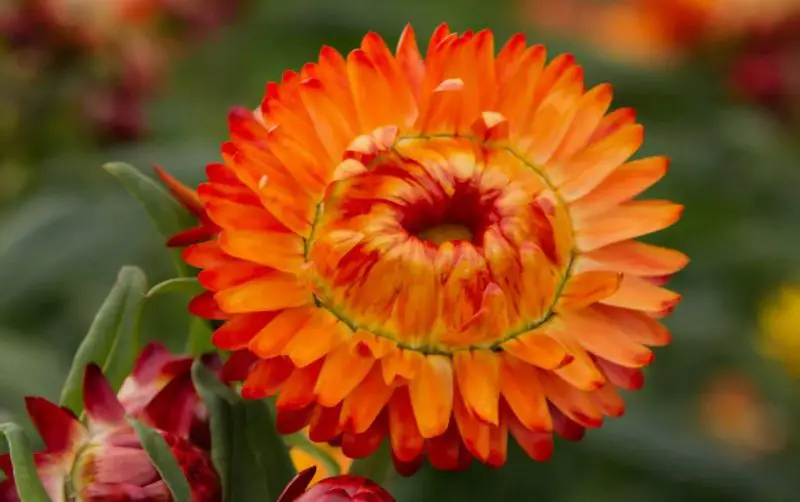
Strawflower is a vibrant annual known for its papery, daisy-like flowers that come in shades of yellow, orange, pink, red, and white. The petals are stiff and papery, giving them a unique texture that holds up well in dried arrangements. These flowers are perfect for adding lasting color to gardens and bouquets.
This plant thrives in full sun and well-drained, moderately fertile soil. It is relatively drought-tolerant once established and doesn’t require excessive watering, making it a low-maintenance option. Deadheading spent blooms helps to encourage more flowers, though they are quite self-sufficient once established.
Strawflower is suitable for USDA zones 2–11, blooming from early summer through fall. Its long-lasting flowers and easy-care nature make it a great choice for gardeners looking for a hardy, low-maintenance annual with unique ornamental appeal.
Clarkia

Clarkia is a charming annual that offers a variety of colorful flowers in shades of pink, red, purple, and white. Known for its cup-shaped blooms, it produces an attractive display of blossoms that can grow up to 3 feet tall. Clarkia’s flowers attract pollinators such as bees and butterflies, making it a valuable addition to any garden.
Clarkia grows best in full sun and well-drained, slightly alkaline soil. It’s a drought-tolerant plant that can thrive with minimal watering, though it will benefit from occasional deadheading to extend its bloom time. It’s easy to grow from seed, and it often self-sows to create beautiful naturalized patches in the garden.
Grown as an annual in USDA zones 3–10, Clarkia blooms from late spring to early fall, making it perfect for adding pops of color to flower beds, borders, and meadow-style gardens.
Godetia (Farewell-to-Spring)
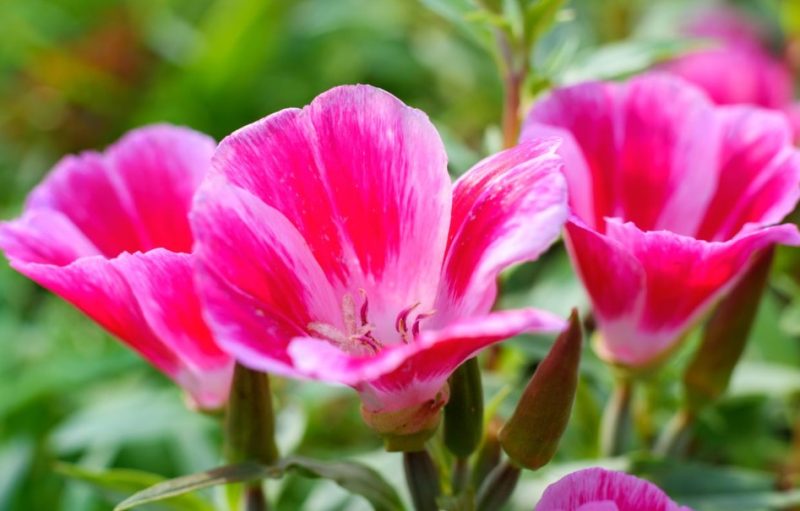
Godetia, commonly known as Farewell-to-Spring, is an annual that produces colorful, cup-shaped flowers in shades of pink, red, white, and purple. Its vibrant blooms are often accented with a silken sheen, making them highly attractive to both humans and pollinators. Godetia has a bushy, compact habit, making it suitable for smaller garden spaces or containers.
This plant thrives in full sun to partial shade and prefers slightly acidic, well-drained soil. It grows best with regular watering and benefits from occasional deadheading to prolong the flowering season. Godetia is also relatively tolerant of cooler temperatures, making it a great early-season bloomer in areas with mild climates.
Godetia is hardy in USDA zones 2–9, blooming from late spring to early summer. Its cheerful flowers provide an early burst of color and are excellent for adding texture and interest to garden beds and mixed containers.
Coreopsis (Annual varieties like C. tinctoria)
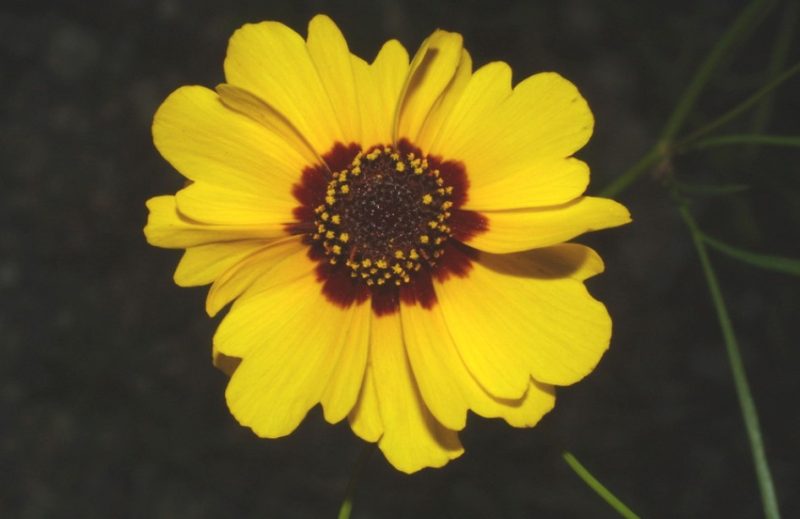
Coreopsis, especially varieties like C. tinctoria, also known as Plains Coreopsis, is a hardy annual that produces bright, daisy-like flowers in shades of yellow, gold, and red. The blooms are often bicolor, with the petals featuring darker tips or centers that add depth to the flower heads. Coreopsis flowers are great for attracting pollinators and can be used in both cutting gardens and natural landscapes.
Coreopsis grows best in full sun and thrives in well-drained, sandy or loamy soil. It is highly tolerant of drought and poor soil conditions, making it a fantastic low-maintenance plant for gardeners who prefer easy-care options. Regular deadheading will promote more blooms and prevent the plant from becoming too leggy.
Coreopsis is suitable for USDA zones 3–9, and its annual varieties like C. tinctoria bloom from mid-spring through fall. This plant adds a bright, cheerful touch to garden beds, borders, and wildflower meadows.


